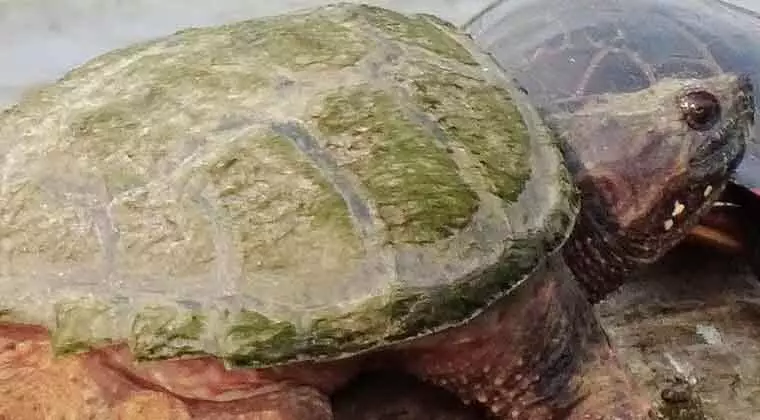Snapping turtles are omnivores, so they need a balanced diet of both meat and vegetation. In the wild, their diet typically consists of aquatic invertebrates, fish, frogs, crayfish, snails, and aquatic plants. When feeding your pet snapping turtle in captivity you can provide them with commercial turtle food pellets or frozen prepared foods such as krill or bloodworms.
You can also supplement their diet with earthworms and feeder fish like goldfish and guppies (which should be gut-loaded before being offered to ensure maximum nutritional value). Additionally, veggies such as kale, spinach, and collard greens along with fruits such as apples or strawberries can be provided occasionally. It’s important to not overfeed your turtle; once every two days is usually sufficient for an adult snapping turtle.
What Eats Snapping Turtles?
Snapping turtles face a variety of predators, including alligators, large fish like bass and northern pike, wading birds such as herons and egrets, raccoons, skunks, foxes, snakes, and even large cats. In some cases, they can also be preyed upon by humans. The mortality rate for juveniles is especially high due to predation from animals that inhabit the same habitats as they do.
What to Feed a Baby Snapping Turtle?
When feeding a baby snapping turtle, it is important to give them food that provides the proper nutrition for their growth and development. A good diet for a baby snapping turtle should include commercially-prepared turtle pellets, as well as fruits and vegetables.
Additionally, live items such as earthworms or crickets can be given occasionally. It is essential to feed your baby snapping turtle in small amounts several times per day rather than one large meal at once so they receive the nutrition they need without overfeeding them.
What Kind of Plants Do Snapping Turtles Eat?
They mainly feed on aquatic vegetation such as duckweed, water lilies, pondweeds, and eelgrass. Other plant matters that snapping turtles may consume include algae, seeds from aquatic plants like cattail or smartweed, and fruits such as grapes or apples that have fallen into the water.
Can Snapping Turtles Eat Fruit?
Snapping turtles are carnivorous reptiles and do not typically eat fruit. However, some snapping turtles may occasionally supplement their diets with fruits or vegetables if they can find them in the wild. It’s important to note that these foods should not replace a diet rich in protein, such as worms, insects, fish, and frog legs.
What is a Snapping Turtle’s Favorite Food?
They have a varied diet that includes insects, fish, amphibians, small mammals, carrion (dead animals), aquatic vegetation such as duckweed and pondweed, mollusks like clams and snails, and crustaceans like crayfish and shrimp. Snapping turtles also sometimes consume algae or fungi.
As you can see their favorite food is quite diverse! However one of their most favored foods would be live prey due to the fact that they have powerful jaws with sharp beaks which make them very effective hunters. These turtles love to ambush their prey by lying motionless in wait for unsuspecting victims to come within striking distance; then quickly darting out from beneath the surface of the water with lightning speed to grab whatever happens to be swimming nearby.
What Vegetables Can I Feed My Snapping Turtle?
If you have a snapping turtle, vegetables can be an important part of their diet. Some good choices include dark leafy greens such as collards, kale, romaine lettuce, and turnip or mustard greens; squash or pumpkin; carrots and sweet potatoes; peas; cauliflower or broccoli florets; green beans; zucchini and herbs like parsley and dandelion greens. You can also feed your turtle store-bought prepared foods that are specifically designed for turtles.
Be sure to avoid giving them iceberg lettuce as it has little nutritional value for them compared to other types of lettuce. Other options include aquatic weeds such as elodea or water hyacinths that you grow in the aquarium yourself, providing a natural source of food for your pet. Finally, adding occasional treats like worms, crickets or even small pieces of fresh fish can give variety to your turtle’s diet while helping maintain its health by providing essential vitamins and minerals not found in some veggies alone.
How Often Should I Feed My Snapping Turtle?
When it comes to feeding your snapping turtle, the frequency depends on a few factors. For younger turtles, you should feed them every day or two. As they get older, you can start cutting back on their meals to three times per week.
It is important not to overfeed your pet as this can lead to health problems such as obesity and increase its risk of contracting infectious diseases. Additionally, when deciding how much food to give your pet each time, consider the size of the turtle and adjust accordingly; smaller turtles will need less food than larger ones. When offering food items like insects and worms make sure that they are appropriately sized for your turtle’s mouth since any pieces too large may pose a choking hazard!
Try not to feed too many vegetables at once; these should be given sparingly in order to ensure proper digestion. Overall, by following these tips you can ensure that your snapping turtle remains healthy and happy with an adequate diet!
Feeding My Snapping Turtles: DON’T TRY THIS AT HOME
Conclusion
When choosing what to feed your snapping turtle, it’s important to consider the nutritional value of the food. While some vegetables and fruits are okay for a treat, meat should be the primary staple in their diet. You can also supplement with commercially available turtle food or pellets.
It is best to speak with a veterinarian before making any major changes to ensure that your pet turtle stays healthy and happy!
